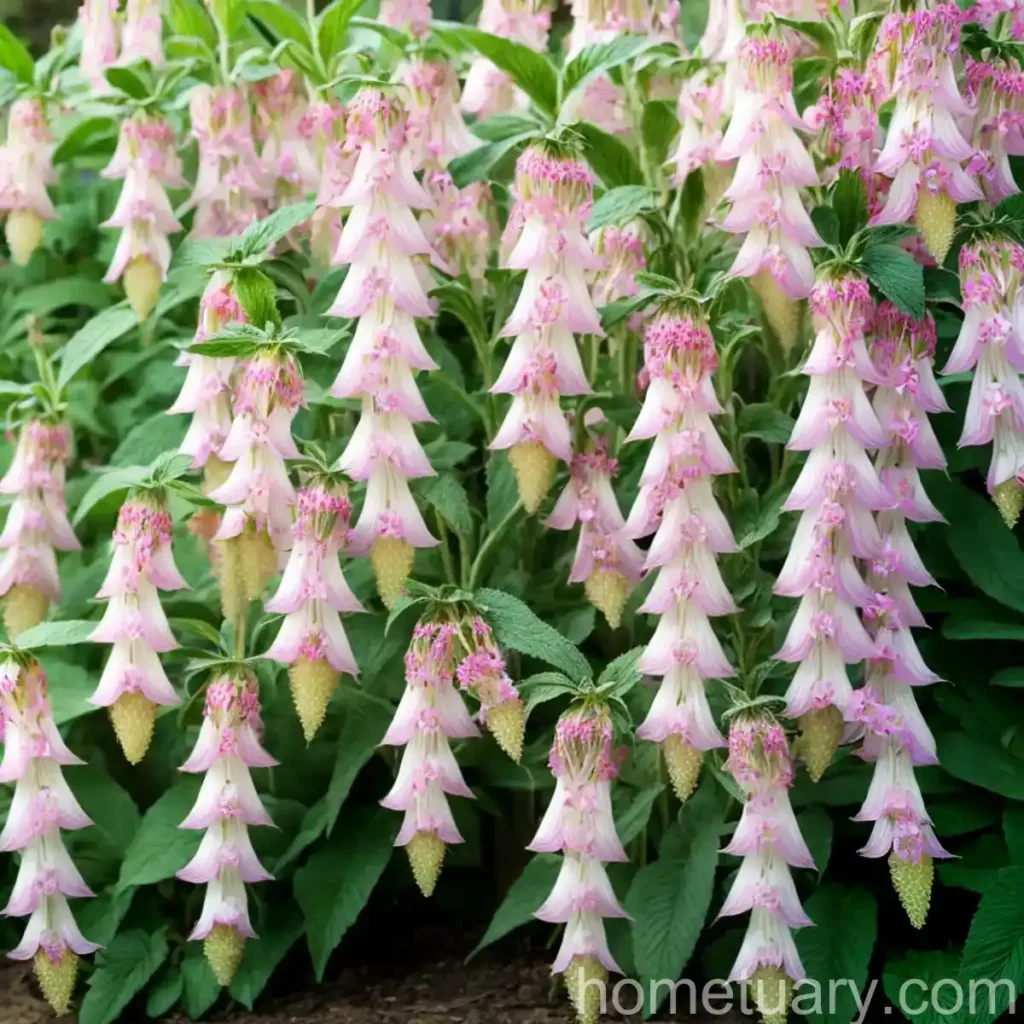Exploring the Enchanting World of Strawberry Foxglove (Digitalis x mertonensis)
In the realm of garden flowers, Digitalis x mertonensis, commonly known as strawberry foxglove, stands as a quintessential beauty that captivates the eye, and possesses a rich history of cultural uses and medicinal significance. This remarkable plant is renowned for its towering height, vibrant blossoms, and unique foxglove shape. In this comprehensive guide, we will delve into the various aspects of this stunning plant, from its cultivation and care to its botanical characteristics and intriguing folklore.
What is Plant Strawberry Foxglove (Digitalis x mertonensis)
Strawberry foxglove, scientifically known as Digitalis x mertonensis, is a captivating biennial or short-lived perennial flowering plant. Belonging to the Plantaginaceae family, this species is a hybrid of Digitalis purpurea and Digitalis grandiflora. It is characterized by its stately growth habit, which can reach heights of up to 3-4 feet (90-120 cm). The flowers of the strawberry foxglove are tubular and bell-shaped, with a mesmerizing combination of colors that resemble the hues of strawberries, hence its charming name.
The leaves of Digitalis x mertonensis are a luscious green and are lance-shaped with a slightly fuzzy texture. The overall appearance of the plant lends an aura of elegance and grace to any garden or landscape. As a biennial or short-lived perennial, strawberry foxglove typically blooms in its second year, producing a profusion of blooms that attract pollinators such as bees and butterflies, making it a valuable addition to any wildlife garden.
Key Takeaways – Strawberry Foxglove (Digitalis x mertonensis)
Before we embark on the journey to explore the intricacies of cultivating and caring for this splendid plant, let’s take a moment to grasp the key takeaways that will guide us through this exploration:
- Cultural Uses: Delve into the historical and cultural uses of strawberry foxglove for various purposes.
- Water: Understand the water requirements for maintaining optimal growth and health of Digitalis x mertonensis.
- Sunlight: Uncover the ideal sunlight conditions needed to nurture vibrant blooms and sturdy foliage.
- Fertilizer: Discover the role of fertilizer in enhancing the growth and blooming potential of the plant.
- Soil: Explore the preferred soil type and composition that supports the development of healthy strawberry foxglove plants.
- Pruning: Learn about the pruning techniques that aid in maintaining the plant’s vigor and enhancing its aesthetic appeal.
- Propagation: Gain insights into the methods of propagating Digitalis x mertonensis to expand your garden’s bounty.
- Container Popularity: Recognize the suitability of growing strawberry foxglove in containers for added versatility in gardening.
Now, let’s immerse ourselves in the enchanting world of strawberry foxglove, unveiling its mysteries and unlocking the secrets to fostering its resplendent beauty.
Strawberry Foxglove Culture
The culture and heritage of strawberry foxglove (Digitalis x mertonensis) extend beyond its biological attributes. This plant has been intertwined with diverse cultural practices, from folklore and symbolism to its historical applications in medicine and gardening. Understanding the cultural significance of this enchanting plant provides a deeper appreciation of its timeless allure.
Uses
Historical and Folklore Significance
Throughout history, the foxglove plant, including the strawberry foxglove variety, has been intertwined with a fascinating tapestry of mythology, symbolism, and practical uses.
- Mythological Significance: In various European and Celtic mythologies, foxglove was often associated with fairies and magical beings. It was believed that the plant’s abundant blossoms served as thimbles for fairies and allowed humans to see them.
- Symbolism: The foxglove plant has been imbued with symbolic meanings, representing diverse qualities such as protection, intuition, and healing, as well as both positive and negative omens in different cultural contexts.
- Medicinal History: Historically, foxglove plants were used in traditional medicine to treat various ailments, particularly heart-related conditions. The plant contains potent cardiac glycosides, such as digitoxin and digoxin, which have been utilized in modern medicine for cardiac treatments.
Water
Proper watering is crucial for the prosperity of Digitalis x mertonensis. While strawberry foxglove is relatively resilient, it thrives in consistently moist soil that prevents it from drying out but does not become waterlogged.
- Regular Watering: Adequate and consistent watering, particularly during dry spells, is essential for the healthy growth and blooming of strawberry foxglove plants.
- Avoid Waterlogging: It is important to ensure that the soil is well-draining to prevent waterlogging, which can lead to root rot and other detrimental conditions.
Sunlight
Strawberry foxglove, like many flowering plants, thrives in specific light conditions that contribute to its robust growth and blossoming potential.
- Partial Shade to Full Sun: Digitalis x mertonensis flourishes in locations with partial shade to full sun exposure. Providing a balance of sunlight and shade throughout the day is beneficial for its overall development.
- Protection from Harsh Afternoon Sun: In regions with intense afternoon sunlight, providing some protection during the hottest part of the day can help prevent stress and sun damage to the plant.
Fertilizer
Appropriate fertilization supports the vigorous growth and blooming of strawberry foxglove, enhancing the vibrancy of its iconic bell-shaped flowers.
- Balanced Fertilizer: Using a balanced, organic fertilizer during the growing season, particularly in early spring, provides essential nutrients for the plant’s development.
- Avoid Over-fertilization: Over-fertilization can lead to excessive foliage growth at the expense of flowering, so it is important to follow recommended guidelines for fertilization.
Soil
Understanding the soil preferences of Digitalis x mertonensis is crucial for creating an optimal environment that fosters its health and vitality.
- Well-draining Soil: Strawberry foxglove thrives in well-draining soil to prevent waterlogged conditions that can compromise root health.
- Rich in Organic Matter: Amending the soil with organic matter, such as compost or well-rotted manure, promotes soil fertility and provides essential nutrients for the plant.
Pruning
Pruning plays a pivotal role in enhancing the aesthetic appeal and overall vigor of strawberry foxglove plants. Proper pruning practices contribute to the plant’s resilience and help maintain its heightened elegance.
- Deadheading: Removing spent blooms through deadheading encourages continued flowering and prevents the plant from expending energy on seed production.
- Leaf Pruning: Trimming back discolored or damaged leaves improves the plant’s appearance and minimizes the risk of disease spread.
- Stem Maintenance: Trimming back overly tall or leggy stems can maintain a more compact and balanced growth habit.
Propagation
Propagating Digitalis x mertonensis allows for the expansion of its enchanting presence in gardens and landscapes, providing an opportunity to nurture new generations of these charming plants.
Division
- Beneficial for Perennial Types: In the case of perennial strawberry foxglove plants, division can rejuvenate older clumps and promote increased flowering.
- Spring Division: Dividing plants in early spring before new growth emerges allows for successful establishment and growth of divided sections.
Seed Propagation
- Collecting Seeds: Harvesting seeds from mature strawberry foxglove plants enables the propagation of new individuals, preserving the plant’s genetic diversity.
- Sowing Seeds: Sowing the collected seeds in well-prepared soil, either in containers or the garden, provides an avenue for nurturing new seedlings.
Container Popularity
The growing popularity of container gardening has extended to encompass a diverse range of plants, including the captivating strawberry foxglove. Cultivating Digitalis x mertonensis in containers provides a flexible and versatile approach to integrating this enchanting plant into various garden settings.
Common Diseases and Pests Affecting Strawberry Foxglove
Disease and pest management are integral components of successful plant cultivation. Understanding the common ailments and pests afflicting strawberry foxglove equips gardeners with the knowledge needed to protect and preserve the health of their plants.
Common Diseases
Strawberry foxglove, like many plants, is susceptible to certain diseases that can hinder its growth and vitality.
- Powdery Mildew: This fungal disease can manifest as a powdery white coating on the leaves, affecting the overall health and appearance of the plant.
- Leaf Spot: Fungal leaf spot diseases can cause unsightly dark spots on the leaves, potentially leading to defoliation if left untreated.
- Root Rot: Excessive moisture or poorly draining soil can contribute to the development of root rot, jeopardizing the plant’s root system and overall health.
Disease Diagnosis
Early detection and accurate diagnosis of plant diseases are critical for implementing effective treatment and preventive measures.
- Regular Inspection: Routinely inspecting plants for any signs of discoloration, spots, or abnormalities can help detect the presence of diseases at an early stage.
- Consulting Experts: Seeking guidance from horticultural experts or local extension services can aid in diagnosing and addressing specific diseases affecting strawberry foxglove.
Common Pests
Pests such as insects and mites can pose a threat to the well-being of strawberry foxglove plants, necessitating proactive pest management strategies.
- Aphids: These small, sap-sucking insects can congregate on tender growth points, causing stunted growth and distortion of foliage.
- Spider Mites: Infestations of spider mites can lead to fine webbing on the undersides of leaves, accompanied by visible stippling and discoloration.
- Slugs and Snails: These voracious feeders can inflict damage by consuming plant foliage and causing unsightly holes in leaves.
Botanist’s Tips
Incorporating effective and sustainable pest control measures can help safeguard strawberry foxglove plants from the detrimental impacts of pest infestations.
- Natural Predators: Encouraging the presence of natural predators, such as ladybugs and lacewings, can help control aphid populations and maintain a balanced ecosystem.
- Cultural Practices: Implementing cultural practices such as removing debris and maintaining proper plant spacing promotes a less hospitable environment for pests and diseases.
Fun Facts About Strawberry Foxglove (Digitalis x mertonensis)
Delving into the enchanting world of strawberry foxglove unveils a treasure trove of captivating facts and intriguing tidbits that add depth to our understanding and appreciation of this remarkable plant.
Symbolism and Folklore
- Magical Associations: In folklore and mythology, foxglove was often linked with enchantment, fairies, and protection, fostering a sense of mystery and wonder around the plant.
- Stately Elegance: The towering stature and striking blooms of Digitalis x mertonensis embody an aura of regal elegance, cementing its position as a revered garden beauty.
- Medicinal Legacy: The historical medicinal uses of foxglove, particularly in treating heart conditions, underscore its significant role in the realm of herbal remedies and traditional medicine.
Biodiversity and Pollinators
- Pollinator Attraction: The bell-shaped blossoms of strawberry foxglove serve as a beacon for pollinators, drawing in bees, butterflies, and other beneficial insects.
- Wildflower Gardens: Incorporating strawberry foxglove into wildflower gardens enriches biodiversity and provides essential forage for pollinators, contributing to ecological balance.
Aesthetic Appeal
- Color Variations: Digitalis x mertonensis exhibits a captivating range of color variations, from pale pinks to deeper hues, adding diversity to its visual allure.
- Vertical Accents: Its tall, spire-like growth habit lends an architectural quality to garden landscapes, creating vertical interest and focal points.
Links to External Resources
As we continue our journey of discovery and appreciation for Digitalis x mertonensis, exploring external resources can offer valuable insights and practical guidance for cultivating and caring for strawberry foxglove.
- Strawberry Foxglove (Digitalis x mertonensis) – Royal Horticultural Society
- Growing Foxgloves – University of Minnesota Extension
- Digitalis x mertonensis – Missouri Botanical Garden
- Foxgloves in the Garden – North Carolina State Extension
In conclusion, the beguiling allure and captivating grace of strawberry foxglove (Digitalis x mertonensis) render it a timeless favorite in gardens and landscapes around the world. Its historical significance, cultural associations, and botanical magnificence make it a captivating subject of exploration for plant enthusiasts and gardeners. By embracing the cultural heritage, understanding its cultivation and care requirements, and appreciating its multifaceted charms, we can fully immerse ourselves in the enchanting world of strawberry foxglove, savoring its awe-inspiring beauty and timeless allure.
The journey of discovery continues as we delve deeper into the botanical wonders and captivating flora that enrich our lives and the natural world around us. Join us as we explore the myriad facets of plant life, discovering the timeless stories and invaluable wisdom that these living wonders have to offer.















